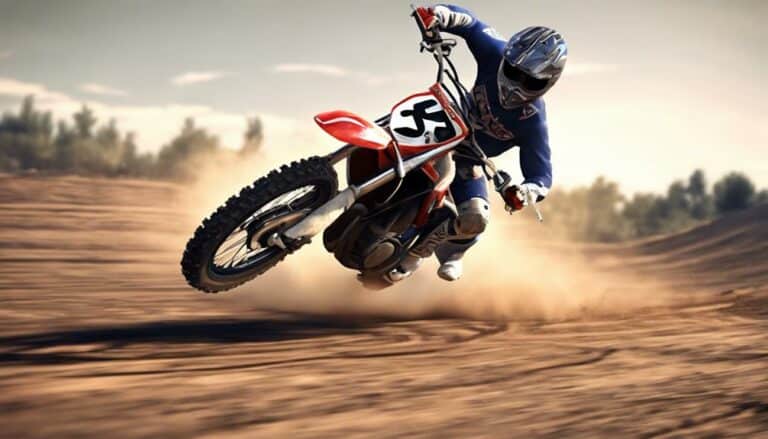When riding those challenging dirt trails on your bike, knowing how to effectively use your front and rear brakes can make all the difference in your ride. The way you apply these brakes can greatly impact your control and safety, but what's the secret recipe for mastering this essential skill?
Let's unravel the art of brake utilization on a dirt bike to help you become a more skilled and confident rider.
Key Takeaways
- Proper brake balance enhances control and performance on dirt trails.
- Front brake for primary stopping power, rear brake for traction and stability.
- Adjust brake pressure for optimal control on varying terrains.
- Master front and rear brake techniques for confident and precise obstacle navigation.
Understanding the Importance of Brake Balance
Understanding the importance of brake balance on a dirt bike is fundamental to mastering control and maximizing performance on challenging terrain. When riding dirt trails, the front brake serves as your primary source of stopping power, allowing you to control your speed effectively. However, solely relying on the front brake can lead to instability and loss of traction, especially on loose surfaces. This is where the rear brake comes into play, offering control and aiding in maintaining traction while also assisting in weight distribution for improved stability.
Properly balancing the use of the front and rear brakes is essential for achieving the best speed control and cornering capabilities. By distributing your weight appropriately and applying both brakes in harmony, you can enhance your overall control over the bike, boosting rider confidence and ensuring a smoother ride through challenging terrain. Remember, mastering brake balance is key to unleashing your dirt biking potential and conquering any obstacles that come your way.
Proper Technique for Front Brake Usage
To optimize your dirt bike's braking performance, mastering the proper technique for utilizing the front brake is essential. The front brake is a powerhouse, providing about 70% of the braking power on a dirt bike, making it crucial for slowing down effectively.
When approaching a turn, apply the front brake before entering while keeping the bike upright to maintain traction. Positioning your body forward on the bike and weighting the outside peg can enhance the front brake's effectiveness, helping you control speed and improve cornering performance.
Utilizing the front brake on flat corners is key to maintaining control and maneuvering dirt tracks smoothly. Remember to incorporate countersteering when using the front brake, allowing you to turn efficiently and operate with precision.
Proper Technique for Rear Brake Usage
Mastering the proper technique for rear brake usage on a dirt bike is fundamental for enhancing control, stability, and stopping power in various riding conditions. When it comes to using the rear brake effectively, consider the following:
- Pre-turn Control: Utilizing the rear brake before entering a turn can prevent unexpected leaning, especially on uneven or slippery surfaces.
- U-Turns and Low-Speed Maneuvers: Applying light pressure on the rear brake during U-turns can help shorten the turning radius and improve maneuverability.
- Stability Enhancement: Weighting the outside peg while using the rear brake enhances stability during U-turns and low-speed maneuvers.
To perfect your rear brake technique, practice is key. Consider honing your skills on a bicycle to understand how the rear brake affects stability and control. By mastering the art of using the rear brake effectively, you can navigate challenging terrains with confidence and finesse.
Mastering Braking in Different Terrain
Adjusting brake pressure on different dirt terrains is essential for optimizing control and traction while riding your dirt bike. When maneuvering varying surfaces, such as loose gravel or mud, understanding how to effectively use your front brake for initial slowing down and then shifting to the rear brake for controlled stops is vital.
In slippery conditions, feathering the rear brake helps prevent skidding, maintaining stability throughout your ride. As you approach corners, applying the brakes beforehand allows you to maintain traction and control, aiding in smoother cornering on challenging dirt tracks.
To master braking in different terrains, consistent practice of braking techniques on various surfaces is key. This repetitive practice helps develop muscle memory, refining your handling skills and enabling you to confidently tackle any type of dirt terrain that comes your way.
Advanced Tips for Brake Control
Enhance your dirt bike control by integrating advanced techniques for brake modulation and precision handling on challenging terrains.
- Master Front Brake Usage: Initiate stopping power with the front brake for quick deceleration, then smoothly add the rear brake for balanced control and enhanced traction.
- Practice Brake Modulation: Independently adjust the front and rear brakes to regulate speed and prevent skidding on loose surfaces, improving your ability to navigate difficult terrains effectively.
- Optimize Body Positioning: Lean forward and distribute weight to the outside foot peg when applying both brakes, maximizing stability and control on the dirt bike while cornering and managing speed.
Conclusion
Now that you've mastered the art of balancing front and rear brakes on your dirt bike, you're unstoppable! With precision and finesse, you can conquer any terrain with ease.
Remember, practice makes perfect, so keep honing your skills and pushing the limits. You're like a symphony conductor, orchestrating the perfect harmony between power and control on your dirt bike.
Keep riding, keep shining, and keep conquering the trails like a true master of the dirt!

